1993 PONTIAC GRAND-AM lights
[x] Cancel search: lightsPage 125 of 306
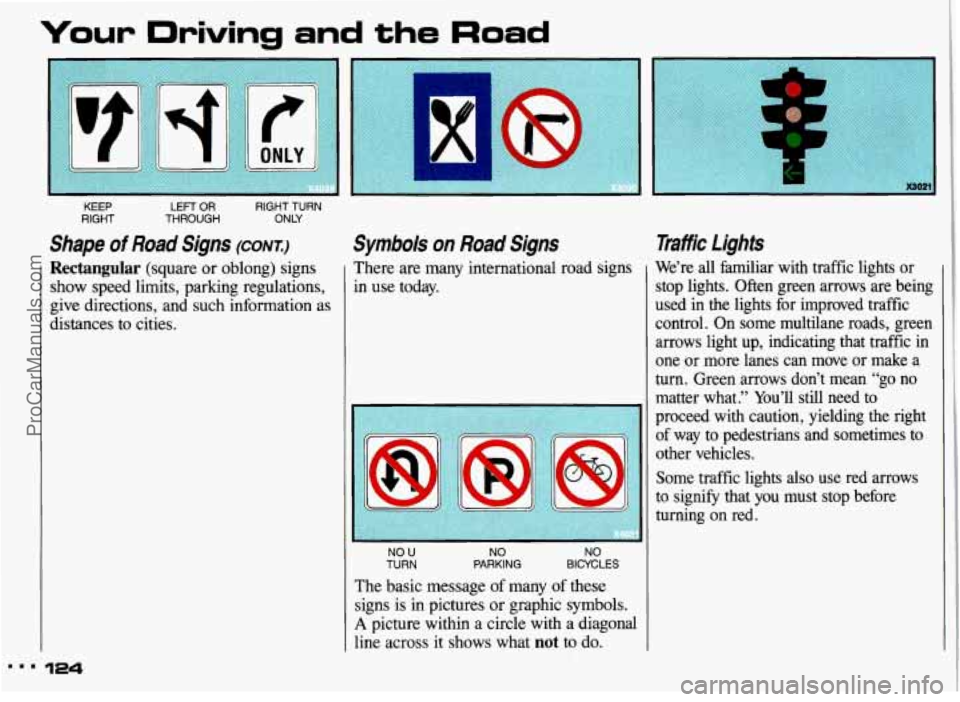
‘Your Driving and the Road
KEEP LEFT OR RIGHT TURN
RIGHT THROUGH ONLY
Shape of Road Signs (CONI)
Rectangular (square
or oblong) signs
show speed limits, parking regulations,
give directions, and such information as
distances to cities.
Symbols on Road Signs Traffic lights
There are many international road signs We’re
all familiar with traffic lights or I in use today.
NO U NO NO TURN PARKING BICYCLES
The basic message of many of these
signs is in pictures or graphic symbols.
A picture within a circle with a diagonal
line across it shows what
not to do. stop lights. Often green arrows are being
used in
the lights for improved traffic
control. On some multilane roads, green
arrows light up, indicating that traffic in
one or more lanes can move or make a
turn. Green arrows don’t mean “go no
matter what.” You’ll still need to
proceed with caution, yielding the right of way to pedestrians and sometimes to
other vehicles.
Some traffic
lights also use red arrows
to signify that you must stop before
turning on red.
ProCarManuals.com
Page 126 of 306
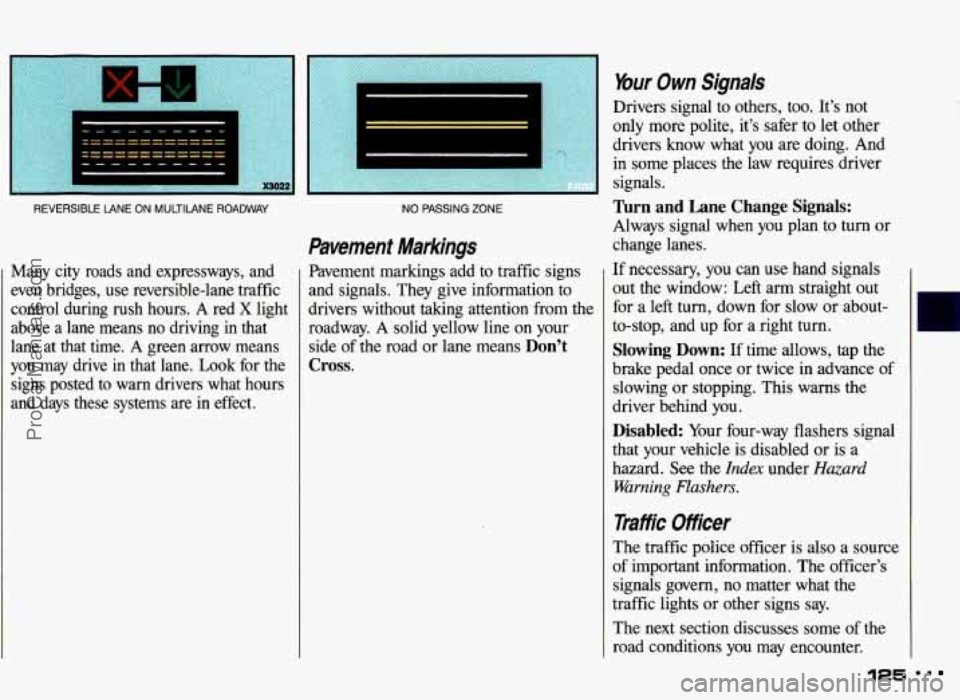
REVERSIBLE tANE ON MULTtlANE ROADWAY
Many city roads and expressways, and
even bridges, use reversible-lane traffic
control during rush hours.
A red X light
above a lane means no driving in that
lane at that time.
A green arrow means
you may drive in that lane. Look for the
signs posted to warn drivers what hours
and days these systems are in effect.
NO PASSING ZONE
Pavement Markings
Pavement markings add to traffic signs
and signals. They give information to
drivers without taking attention from the
roadway.
A solid yellow line on your
side of the road or lane means
Don’t
Cross.
bur Own Signals
Drivers signal to others, too. It’s not
only more polite, it’s safer to let other
drivers
know what you are doing. And
in some places the law requires driver
signals.
Turn and Lane Change Signals:
Always signal when you plan to turn or
change lanes.
If necessary,
you can use hand signals
out the window:
Left arm straight out
for
a left turn, down for slow or about-
to-stop, and up for a right turn.
Slowing Down: If time allows, tap the
brake pedal once or twice
in advance of
slowing
or stopping. This warns the
driver behind you.
Disabled: Your four-way flashers signal
that your vehicle is disabled
or is a
hazard. See the
Index under Hazard
Warning Flashers.
liffk Ofiiceer
The traffic police officer is also a source
of important information. The officer’s
signals govern, no matter what the
traffic lights or other signs
say.
The next section discusses some of the
road conditions you may encounter.
125
ProCarManuals.com
Page 138 of 306
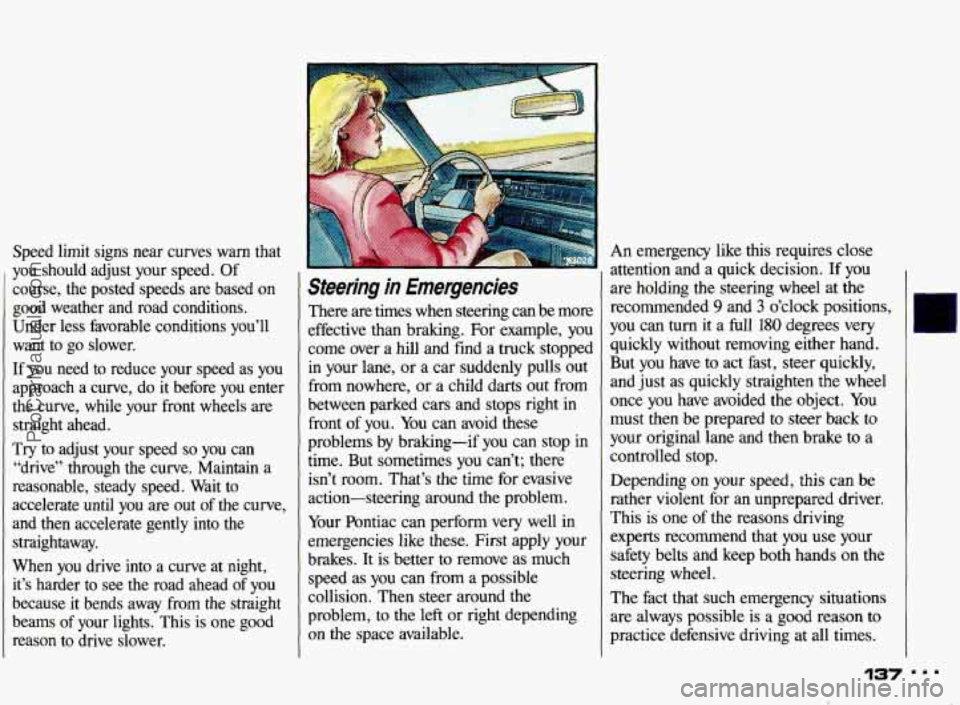
Speed limit signs near curves warn that
you should adjust your speed. Of
course, the posted speeds are based
on
good weather and road conditions.
Under less favorable conditions you’ll
want to go slower.
If you need to reduce your speed as you
approach a curve, do it before you enter
the curve, while your front wheels are
straight ahead.
Try to adjust your speed
so you can
“drive” through the curve. Maintain a
reasonable, steady speed. Wait to
accelerate until
you are out of the curve,
and then accelerate gently into the
straightaway.
When
you drive into a curve at night,
it’s harder to see the road ahead of you
because it bends away from the straight
beams of your lights. This is one good
reason to drive slower.
Steering in Emergencies
There are times when steering can be more
effective than braking. For example, you
come over a hill and find a truck stopped
in your lane, or a car suddenly pulls out
from nowhere, or a child darts out from
between parked cars and stops right in
front of you.
You can avoid these
problems by braking-if
you can stop in
time. But sometimes you can’t; there
isn’t
room. That’s the time for evasive
action-steering around the problem.
Your Pontiac can perform very well in
emergencies like these. First apply your
brakes. It is better to remove as much
speed as you can from a possible
collision. Then steer around the
problem, to the left or right depending
on the space available. An emergency like this requires
close
attention and
a quick decision. If you
are holding the steering wheel at the
recommended
9 and 3 o’clock positions,
you can turn it a
full 180 degrees very
quickly without removing either hand.
But
you have to act fast, steer quickly,
and just as quickly straighten the wheel
once
you have avoided the object. You
must then be prepared to steer back to
your original lane and then brake to a
controlled stop.
Depending on your speed, this can
be
rather violent for an unprepared driver.
This is one of the reasons driving
experts recommend that
you use your
safety belts and keep both hands on the
steering wheel.
The fact that such emergency situations
are always possible is a good reason to
practice defensive driving at all times.
ProCarManuals.com
Page 141 of 306
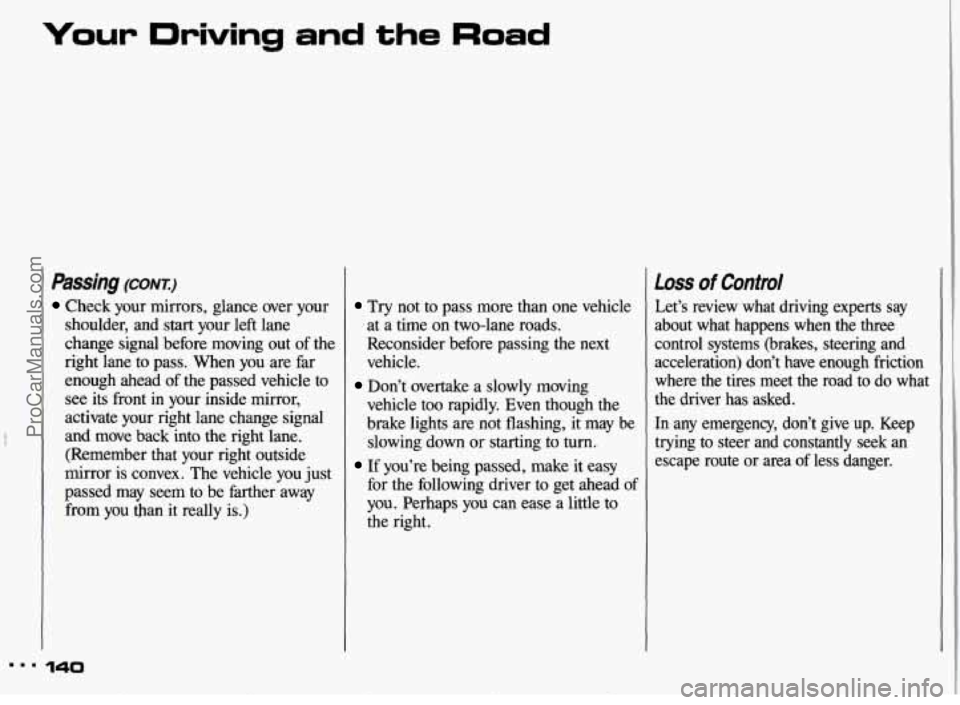
Your Driving and the Road
Passing (CONT.)
Check your mirrors, glance over your
shoulder, and
start your left lane
change signal before moving out of the
right lane to pass. When you are far
enough ahead of the passed vehicle to
see its front in your inside mirror,
activate your right lane change signal
and move back into the right lane.
(Remember that your right outside
mirror
is convex. The vehicle you just
passed may seem to be farther away
from
you than it really is.)
140
Try not to pass more than one vehicle
at a time on two-lane roads.
Reconsider before passing the next
vehicle.
vehicle too rapidly. Even though the
brake lights are not flashing, it may be
slowing down
or starting to turn.
If you’re being passed, make it easy
for the following driver to get ahead of
you. Perhaps you can ease a little to
the right.
Don’t overtake a slowly moving
Loss of Control
Let’s review what driving experts say
about what happens when the three
control systems (brakes, steering and
acceleration) don’t have enough friction
where the tires meet the road to do what
the driver has asked.
In any emergency, don’t give up. Keep
trying to steer and constantly seek an
escape route or area
of less danger.
ProCarManuals.com
Page 143 of 306

Your Driving and the Road
Driving at Night
Night driving is more dangerous than
day driving. One reason is that some
drivers are likely to be impaired-by
alcohol or drugs, with night vision
problems, or by fatigue.
Here are some tips on night driving.
Drive defensively. Remember, this is
the most dangerous time.
Don’t drink and drive. (See the Index
under Drunken Driving for more on
this problem.)
Adjust your inside rearview mirror to
reduce the glare from headlights
behind you.
142
Since you can’t see as well, you may
need to slow down and keep more
space between you and other vehicles.
It’s hard to tell how fast the vehicle
ahead is going just by looking at its
taillights.
speed roads. Your headlights can light
up only
so much road ahead.
Slow down, especially on higher
In remote areas, watch for animals.
If you’re tired, pull off the road in a
safe place and rest.
Night Vision
No one can see as well at night as in the
daytime. But as we get older these
differences increase.
A 50-year-old
driver may require at least twice as
much light to see the same thing at night
as a 20-year-old.
What you do
in the daytime can also
affect your night vision. For example, if
you spend the day in bright sunshine you
are wise to wear sunglasses. Your eyes
will have less trouble adjusting to night.
But if you’re driving, don’t wear
sunglasses at night. They may cut down
on glare from headlights, but they also
make a lot of things invisible that should
remain visible-such as parked cars,
obstacles, pedestrians, or even trains
blocking railway crossings. You may
want to
put on your sunglasses after you
have pulled into a brightly-lighted
service or refreshment area. Eyes
ProCarManuals.com
Page 144 of 306

shielded from that glare may adjust
more quickly to darkness back on the
road. But be sure to remove your
sunglasses before you leave the service
area.
You can be temporarily blinded by
approaching lights. It can take a second
or two, or even several seconds, for your
eyes to readjust to the dark. When you
are faced with severe glare (as from a
driver who doesn’t lower the high
beams, or a vehicle with misaimed
headlights), slow down a little. Avoid
staring directly into the approaching
lights. If there is a line of opposing
traffic, make occasional glances over the line of headlights to make certain that
one of the vehicles isn’t starting to move
into your lane. Once you are past the
bright lights, give your eyes time to
~ readjust before resuming speed.
High Beams
If the vehicle approaching you has its
high beams on, signal by flicking yours
to high and then back to low beam. This
is the usual signal to lower the headlight
beams. If the other driver still doesn’t lower the beams, resist the temptation to
put your high beams on. This only
makes two half-blinded drivers.
On a freeway, use your high beams only
in remote areas where you won’t impair
approaching drivers. In some places,
like cities, using high beams is illegal.
When you follow another vehicle on a
freeway or highway, use low beams.
True, most vehicles now have day-night
mirrors that enable the driver to reduce
glare. But outside mirrors are not of this
type and high beams from behind can
bother the driver ahead.
A Few More Night Driving
Suggestions
Keep your windshield and all the glass
on your vehicle clean-inside and out.
Glare at night is made much worse by
dirt on the glass. Even the inside
of the
glass can build up a film caused by dust.
Tobacco smoke also makes inside glass
surfaces very filmy and can be a vision
hazard
if it’s left there.
Dirty glass makes lights dazzle and
flash more than clean glass would,
making the pupils
of your eyes contract
repeatedly. You might even want to keep
a cloth and some glass cleaner in your
vehicle if you need to clean your glass
frequently.
’143
F
ProCarManuals.com
Page 145 of 306
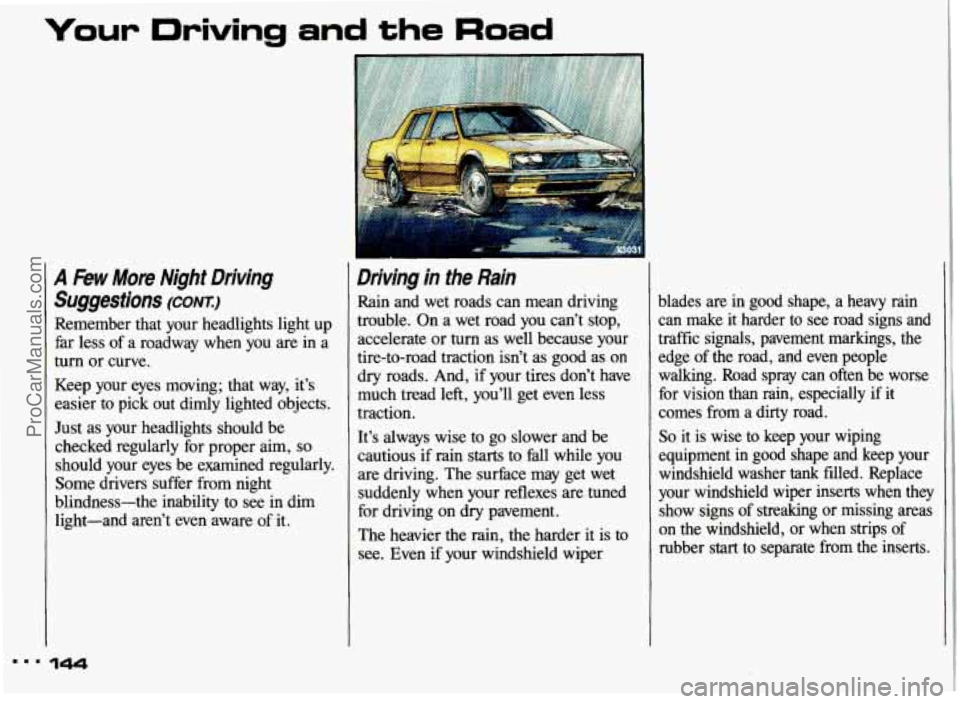
Your Driving and the Road
A &w More Night Driving
Suggestions
(CONTJ
Remember that your headlights light up
far
less of a roadway when you are in a
turn or curve.
Keep your eyes moving; that way,
it’s
easier to pick out dimly lighted objects.
Just as your headlights should be
checked regularly for proper aim,
so
should your eyes be examined regularly.
Some drivers suffer from night
blindness-the inability to see
in dim
light-and aren’t even aware
of it.
144
Driving in the Rain
Rain and wet roads can mean driving
trouble. On a wet road you can’t stop,
accelerate or
turn as well because your
tire-to-road traction isn’t as good
as on
dry roads.
And, if your tires don’t have
much tread left, you’ll get even less
traction.
It’s always wise to go slower and be
cautious
if rain starts to fall while you
are driving. The surface may get wet
suddenly when your reflexes are tuned
for driving on
dry pavement.
The heavier the
rain, the harder it is to
see. Even if your windshield wiper blades are in good shape, a heavy rain
can make it harder to see road signs and
traffic signals, pavement markings, the edge of the road, and even people
walking. Road spray can often be worse for vision than rain, especially
if it
comes from
a dirty road.
So it is wise to keep your wiping
equipment in
good shape and keep your
windshield washer
tank fdled. Replace
your windshield wiper inserts when they show signs of streaking or missing areas
on the windshield, or when strips of
rubber
start to separate from the inserts.
ProCarManuals.com
Page 147 of 306
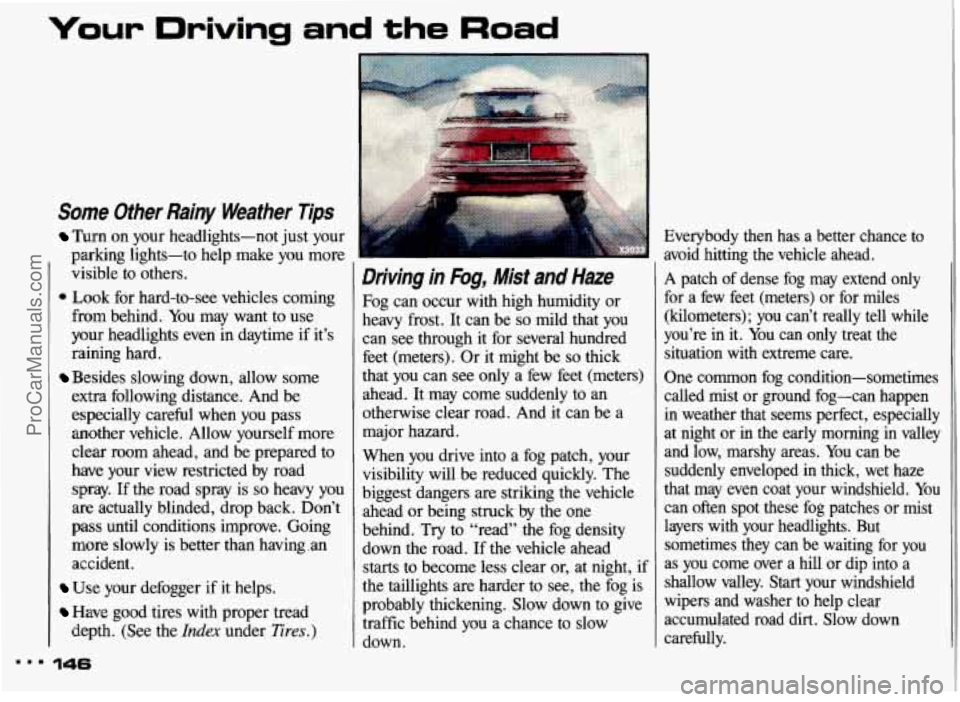
Your Driving and the Road
Some Other Rainy Weather Tips
Turn on your headlights-not just your
parking lights-to help make you more
visible to others.
* Look for hard-to-see vehicles coming
from behind. You may want to use
your headlights even in daytime
if it’s
raining hard.
Besides slowing down, allow some
extra following distance. And be
especially careful when you pass
another vehicle. Allow yourself more
clear room ahead, and be prepared
to
have your view restricted by road
spray. If the road spray is
so heavy you
are actually blinded, drop back. Don’t
pass until conditions improve. Going
more slowly is better than having an
accident.
Use your defogger if it helps.
Have good tires with proper tread
depth. (See
the Index under Tires.)
Driving in Fog, Mist and Haze
Fog can occur with high humidity or
heavy frost. It can be
so mild that you
can see through it for several hundred
feet (meters). Or it might be
so thick
that you can see only a few feet (meters)
ahead.
It may come suddenly to an
otherwise clear road. And it can be a
major hazard.
When you drive into a fog patch, your
visibility will be reduced quickly. The
biggest dangers are striking the vehicle
ahead or being struck by the one
behind.
Try to “read’’ the fog density
down the road. If the vehicle ahead
starts
to become less clear or, at night, if
the taillights are harder to see, the fog is
probably thickening. Slow down to give
traffic behind you a chance to slow
down. Everybody then has a better chance
to
avoid hitting the vehicle ahead.
A patch of dense fog may extend only
for a few feet (meters)
or for miles
(kilometers); you can’t really tell while
you’re
in it. You can only treat the
situation with extreme care.
One common fog condition-sometimes called mist or ground fog-can happen
in weather that seems perfect, especially
at night or in the early morning
in valley
and low, marshy areas. You can be
suddenly enveloped in thick, wet haze
that may even coat your windshield. You
can often spot these fog patches or mist
layers with your headlights.
But
sometimes they can be waiting for you
as you come over a hill or dip into a
shallow valley. Start your windshield
wipers and washer to help clear
accumulated road dirt. Slow down
carefully.
... 146
ProCarManuals.com